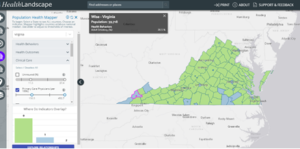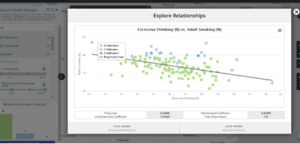By Yang Wang, Chinese General Practice Press, wangyang@chinagp.net
Question: How to apply a novel geospatial hot-spot and cold-spot methodology in helping public health and primary care policy makers and practitioners to target interventions in areas with the highest need and to identify possible local risk factors?
Findings: GIS technology can be used to build a digital platform based on national and regional medical databases. Tier D counties were identified as DMPrevCare cold-spots (clusters of counties with low rates of diabetic testing). Tier C counties were those counties that were DMPrevCare cold-spots and Medicare spending hot-spots (clusters of counties with high rates of spending). Tier B counties were those counties that were DMPrevCare cold-spots and preventable hospitalization hot-spots (clusters of counties with high rates of preventable hospitalizations). Finally, tier A priority counties were identified as DMPrevCare cold-spots and Medicare spending hot-spots and preventable hospitalization hot-spots
Meaning: GIS technology and platform can provide effective and intuitive information support for policy makers and practitioners in public health, primary care and family medicine. It can help them to achieve more effective medical resources allocation and implement health intervention to target population.
HealthLandscape, which is a division of the American Academy of Family Physicians (AAFP), aims to democratize the use of geographic information systems (GIS) for understanding health and communities and conduct geospatial research to improve population health. In this study, authors use GIS to identify 3,046 counties with low rates of diabetic testing (cold-spots, Tier D), 98 counties were DMPrevCare cold-spots and with high rates of Medicare spending (Medicare spending hot-spots), 78 counties were DMPrevCare cold-spots and with high rates of preventable hospitalizations (hospitalization hot-spots), and 62 counties were identified as DMPrevCare cold-spots and Medicare spending hot-spots and preventable hospitalization hot-spots (High priority region, Tier A). According to statistical analysis, Tier A were more likely to have higher percentages of under-resourced populations and had higher preventable hospitalizations, Medicare spending and prevalence of diabetes compared with Tier D counties.
HealthLandscape also builds web-based GIS tools for exploring population health which are open to the public. From the perspective of the editor, the application of HealthLandscape (https://www.healthlandscape.org/base) is not only a GIS tool which provides an intuitive and easy-to-use population health information to policy makers, researchers and primary care practitioners. Its main advantage is its openness and comprehensiveness. For example, I can easily manipulate it to screen out all counties of Virginia(USA) which both had a higher adult smoking rate and excessive drinking rate (more than 20%), detailed data of Wise County and conducted a simple linear correlation analysis of these two factors in this area. Even for other countries, if they can develop such a platform, and open it to primary care practitioners, it will help them to allocate resources and focus on the most critical areas, populations and risk factors.

Figure 1: Screening and display of specific areas in a HealthLandscape

Figure 2: Simple correlation analysis of local risk factors in healthLandscapes
In the current global Covid-19 epidemic, GIS tools also provide powerful information support for the public and population health. Many famous GIS Tools such as “CSSE” (USA), “New Covid-19 Health Map” (USA), “National Covid-19 outbreak Real-time Update” (China) have updated the latest information on the spread of the epidemic in real time and displayed it visually. They have provided powerful information support for our war against the epidemic.
Reference:
- Topmiller M, Shaak K, Mallow PJ. et al. Identifying diabetes management opportunity areas in the USA. Family Medicine and Community Health 2020;8:e000293. doi: 10.1136/fmch-2019-000293. Link:https://fmch.bmj.com/content/8/1/e000293
Conflict of Interest Statement: None declared